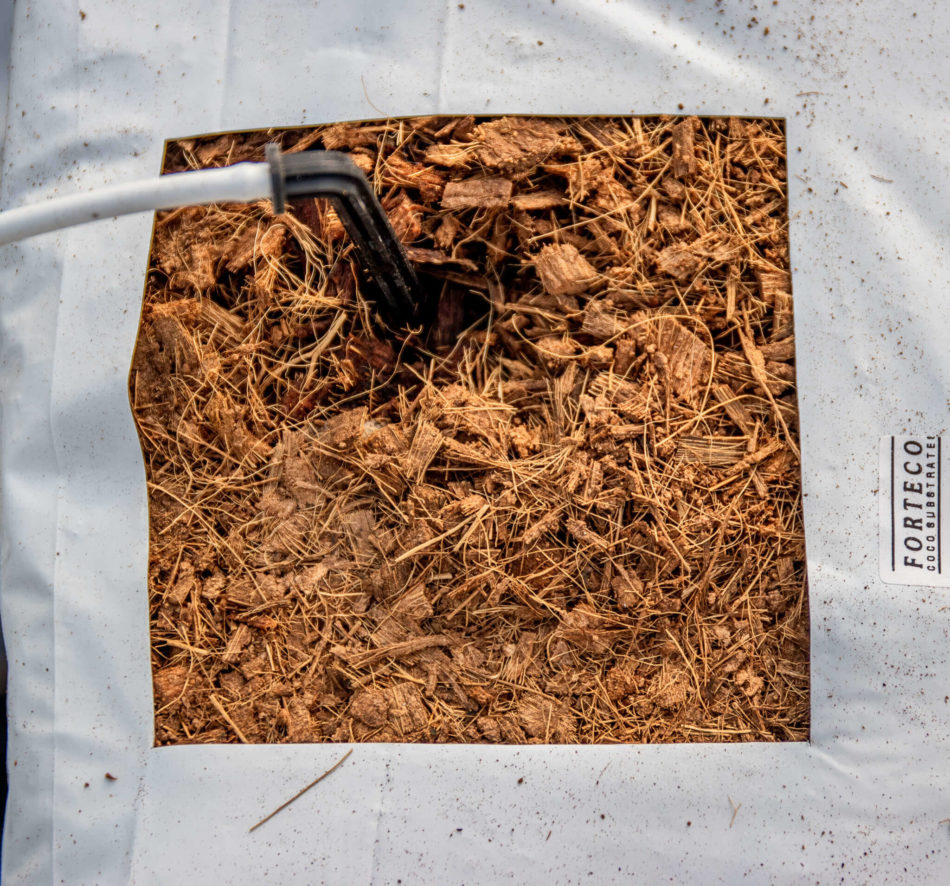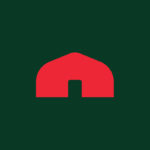Greenhouse-grown plants (and any plants, for that matter) cannot survive without some form of irrigation. While there are different types of greenhouse irrigation systems available – including sprinkler and subsurface systems – we use a drip irrigation system because of its efficiency and accuracy. Let’s take a closer look at how our drip irrigation system works and what informs our crop irrigation strategy!
What Is Irrigation?
But first, what is irrigation and why is it important?
Irrigation is an agricultural process that applies water to crops at optimal intervals and quantities. When plants are irrigated with water, they are given one of the essential elements needed for the process of photosynthesis to occur.

Photosynthesis is a process in which plants create their own food. For a plant to complete the photosynthesis process, it needs a combination of different factors, including light, carbon dioxide (CO2), and water. When these elements enter a plant, light will activate reactions in structures inside the plant cell called chloroplasts, and the result will be energy for the plant in the form of glucose. At this time, oxygen will also be released to the atmosphere for us to breathe!
Water is an essential part of the photosynthesis process. This is why it is so important for a greenhouse operation to establish a strong irrigation strategy that delivers the optimal amount of water to its crop at the right times and in the proper volumes.
What is Drip Irrigation?
Drip irrigation is exactly what it sounds like – irrigation administered to a crop through dripper technology. Every plant gets its own dripper tube, which is typically placed in the back corner of the substrate block in which our plants sit. It is also important to ensure the dripper is not pushed in too deep to the block – this makes it easier for the plant’s roots to access the nutrient water.

Drip irrigation is an efficient way to irrigate greenhouse crops – the placement of our dripper tubes makes it easy for our Growers to deliver precise volumes of nutrient water directly to the root systems of our plants.
Our drip irrigation process uses a pressure compensated drip tube system that releases a specified volume of water once x amount of water pressure is applied to the dripper’s release valve. This allows for water and nutrients to be evenly distributed across our entire crop.
With greater efficiency and precision than other irrigation systems, establishing a drip irrigation strategy made the most sense for us – after all, as a commercial-sized greenhouse operation, we have hundreds of thousands of plants to irrigate every single day!
The Greenhouse Irrigation Strategy
When determining an irrigation strategy, our Growers have many factors to consider, including seasonal temperatures, light levels, crop development stages, and drydown levels.
Seasonal Temperatures
When temperatures fluctuate at different times of the year, it has a strong effect on our irrigation strategy. In the summer months, when temperatures run very high and are more difficult to control internally, we generally need to irrigate our plants more often because they consume higher volumes of water. In contrast, we don’t irrigate our plants as much during the winter months because internal temperatures are easier to maintain in the winter, and the plants generally don’t consume as much water.
Seasonal Light Levels
Just as temperature informs irrigation needs, so do light levels – the more sunlight shining on our plants, the more they generally need to be irrigated. This means that, when the sun stays out for a longer period during the summer, our plants need more water, and when days are shorter during the winter months, we don’t need to irrigate our plants as often.
Remember the process of photosynthesis – light is what activates a plant’s energy creation process, so more light means a plant will start working harder to grow leaves and fruit (which means more elements like water and CO2 are needed if a plant is going to successfully create glucose to feed itself).

Crop Development
A crop’s needs also shift as it goes through different maturation stages, which means our irrigation strategy needs to shift with it! It is up to our Growers to monitor our crop’s development so that the necessary changes can be made to the irrigation strategy based on the crop’s maturation status.
Drydown Levels
Drydown refers to how much a substrate (which, in our case, is coconut fiber) has dried out. Drydown levels help inform our day-to-day irrigation strategy. If the coconut fiber block has dried out, it will weigh less and will likely require irrigation – but if the coconut fiber slab is still full of moisture, it will weigh more and likely not be irrigated right away. To calculate drydown levels, our Growers use a grow scale that weighs the plant base.
Once a strategy has been developed, our Growers use PRIVA to make changes to our irrigation settings. Our Growers can either update the system at PRIVA terminals stationed throughout our facilities, or on their work station computers or smartphones.
Running Water: Where Water Travels in a Greenhouse
From the moment we pump clean municipal water into our greenhouses, our irrigation water begins an exciting journey!
Holding Tanks

Inside every greenhouse facility, there are three large water storage tanks – these contain clean water, untreated water, and treated water. When we pump clean municipal water into our greenhouses, that water is stored in the clean water tank.
We use a closed-loop irrigation system, which means that excess water that our plants don’t take up through their root systems is collected, tested, cleaned, and sent back out to the plants. When we collect this excess water, it is stored in the untreated water storage tank until it is ready to be tested, cleaned, and sent back out to our plants. Once it has been treated, it is stored in the treated water storage tank until it is time to irrigate.
Mixing in Nutrients
We make sure our plants get the proper amount of nutrients they need by mixing variety-specific, nutrient-rich fertilizers in large mixing tanks.
Every plant variety requires a specific amount of different nutrients for optimal growth. However, almost all fertilizer recipes include nutrients like magnesium, iron, nitrogen, potassium, and calcium.
When it is time to irrigate our plants, a mechanism called an injector takes a specific volume of clean water from the clean water tank, a specific volume of treated water from the treated water tank, and a specific amount of the fertilizer recipe from the mixing tanks and blends all three of these solutions together. The final nutrient water mixture is then pumped out to our plants in the greenhouse!
Water Distribution & Collection
When the nutrient water is distributed to our crops, it is fed directly to each plant’s root system through drip irrigation tubes.

Even though every plant is fed the proper amount of nutrient water, it’s very easy for water to build up in a growing medium and potentially cause root damage – unless the excess water is drained away. For this reason, we chose to use coconut fiber as our growing medium because it drains excess water well, keeping our plants’ roots healthy!
Underneath every plant row we have installed gutters that collect excess nutrient water. Our gutters are installed on a slight slant, allowing drainage water to be gravity fed into a collection basin at the lowest point of the greenhouse. From here, drainage water gets pumped into our untreated water storage tank until it gets cleaned and added to the treated water supply.
Our closed-loop irrigation system allows us to irrigate efficiently, accurately, and sustainably!
Fun Facts on Greenhouse Irrigation
Did you know?
Depending on if a plant is generative or vegetative, the irrigation strategy changes. A generative plant grows more fruit than vegetation, whereas a vegetative plant grows more vegetation and less fruit.
Did you know?
The optimal temperature range we like to keep our nutrient water at is somewhere between 18 and 20 degrees Celsius. It’s important to pay attention to nutrient water temperature because if you feed a plant water that is too cold, it can shock the root system, and if you feed it water that is too warm, it can lead to the development of certain root diseases.
Did you know?
We send samples of our nutrient water to a laboratory for testing on a regular basis to ensure we are feeding our plants the best food possible!
Water for the Win!
With a sustainable and efficient irrigation strategy in place, we keep our plants happy and healthy every single day! But as NatureFresh™ Farms continues to expand our operations, revising and improving upon our existing irrigation strategy will be an important part of our continued growth and expansion.



